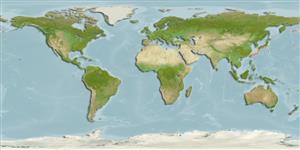>
Perciformes/Uranoscopoidei (Sand dwellers) >
Pinguipedidae (Sandperches)
Etymology: Parapercis: Greek, para = the side of + Greek, perke = perch (Ref. 45335); phenax: Name from a Greek word meaning imposter, refers to its resemblance to, and previous misidentification as, P. roseoviridis.
More on authors: Randall & Yamakawa.
Environment: milieu / climate zone / depth range / distribution range
Ecologia
marinhas batidemersal; intervalo de profundidade 322 - 600 m (Ref. 75889). Temperate
Northwest Pacific: Japan.
Tamanho / Peso / Idade
Maturity: Lm ? range ? - ? cm
Max length : 18.0 cm SL macho/indeterminado; (Ref. 75889); 14.7 cm SL (female)
Descrição breve
Chaves de identificação | Morfologia | Morfometria
Espinhos dorsais (total) : 4 - 5; Raios dorsais moles (total) : 23 - 24; Espinhos anais: 1; Raios anais moles: 19 - 20; Vértebras: 31 - 33. This species is distinguished by the following characters: D IV-V (rarely IV); A I, 19-20 (usually 19); pectoral rays 19-20 (usually 19); lateral-line scales 60-64; gill rakers 4-7 + 10-13; canine teeth 3 pairs, anteriorly in lower jaw; palatine teeth present; body depth 5.0-5.95 in SL; head length 3.45-3.6 in SL; last 2 dorsal spines subequal, the last usually the longest, 3.8-4.15 in HL; last interspinous membrane of dorsal fin attached to the first dorsal soft ray nearly 1/2 length of ray from its base; caudal fin slightly rounded; pelvic fins reaching or extending slightly beyond anus, 1.25-1.55 in HL; body pink dorsally, lavender-white ventrally, with a series of 10 short dusky green to yellow bars on upper side of body (indistinct dorsally), the last 2 on caudal peduncle nearly merged; spinous portion of dorsal fin largely black in color (Ref. 75889).
Life cycle and mating behavior
Maturidade | Reprodução | Desova | Ovos | Fecundidade | Larvas
Randall, J.E. and T. Yamakawa, 2006. Parapercis phenax from Japan and P. banoni from the Southeast Atlantic, new species of Pinguipedid fishes previously identified as P. roseoviridis. Zool. Stud. 45(1):1-10. (Ref. 75889)
Categoria na Lista Vermelha da IUCN (Ref. 130435: Version 2024-1)
Ameaça para o homem
Harmless
Utilização humana
Ferramentas
Relatórios especiais
Descarregue XML
Fontes da internet
Estimates based on models
Preferred temperature (Ref.
123201): 10.4 - 14.7, mean 12.7 °C (based on 61 cells).
Phylogenetic diversity index (Ref.
82804): PD
50 = 0.5000 [Uniqueness, from 0.5 = low to 2.0 = high].
Bayesian length-weight: a=0.00692 (0.00314 - 0.01524), b=3.06 (2.88 - 3.24), in cm total length, based on LWR estimates for this Genus-body shape (Ref.
93245).
Nível Trófico (Ref.
69278): 3.5 ±0.4 se; based on size and trophs of closest relatives
Resiliência (Ref.
120179): Elevada, tempo mínimo de duplicação da população menor que 15 meses (Preliminary K or Fecundity.).
Fishing Vulnerability (Ref.
59153): Low vulnerability (12 of 100).
